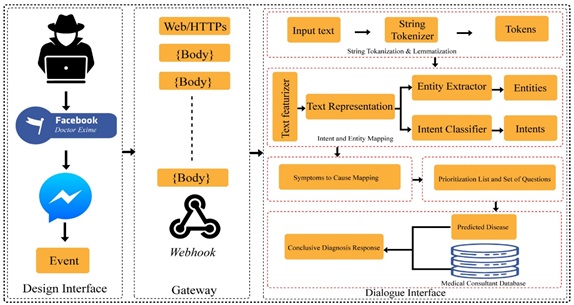Health Consultant Bot: Primary Health Care Monitoring Chatbot for Disease Prediction
DOI:
https://doi.org/10.33411/ijist/2022040115Keywords:
Chatbot, Disease Prediction, Health monitoring, HealthcareAbstract
This research paper presents a disease prediction chatbot that is intelligent enough to communicate with patients to predict their disease by detecting their symptoms through natural language processing. This system allows the user to describe their medical health condition in natural language, and by processing their natural language-based statement, our system detects the symptoms, predicts the disease, and provides basic precautions as well as a brief introduction about the disease. We have used IBM Watson Assistant to build this system. Watson assistant provides several machine learning algorithms to process user statements and symptoms extraction. In our system, symptoms were mapped by considering the community data which resulted in a predicted disease. Our system provides the relevant information about the predicted disease from the system's database. In an experimental evaluation, we carried out a study having 156 subjects, who interact with the system in a daily use scenario. Results show the effectiveness and accuracy of our system to support the patient in taking good care of their health.
References
REFERENCES
V. Della Mea, “What is e-Health (2): The death of telemedicine?,” J. Med. Internet Res., vol. 3, no. 2, pp. 6–7, 2001, doi: 10.2196/JMIR.3.2.E22.
M. Polignano, F. Narducci, A. Iovine, C. Musto, M. De Gemmis, and G. Semeraro, “HealthAssistantBot: A Personal Health Assistant for the Italian Language,” IEEE Access, vol. 8, pp. 107479–107497, 2020, doi: 10.1109/ACCESS.2020.3000815.
S. Shrestha, A. S. Thakuri, and R. Devkota, “Health Maintenance Practices Among Nurses of a Tertiary Level Hospital of Nepal,” J. Coll. Med. Sci., vol. 14, no. 2, pp. 69–74, Jul. 2018, doi: 10.3126/JCMSN.V14I2.19126.
S. J. Du Preez, M. Lall, and S. Sinha, “An intelligent web- based voice chat bot,” IEEE EUROCON 2009, EUROCON 2009, pp. 386–391, 2009, doi: 10.1109/EURCON.2009.5167660.
D. Madhu, C. J. N. Jain, E. Sebastain, S. Shaji, and A. Ajayakumar, “A novel approach for medical assistance using trained chatbot,” Proc. Int. Conf. Inven. Commun. Comput. Technol. ICICCT 2017, pp. 243–246, Jul. 2017, doi: 10.1109/ICICCT.2017.7975195.
K. Kuligowska, “Commercial Chatbot: Performance Evaluation, Usability Metrics and Quality Standards of Embodied Conversational Agents,” Prof. Cent. Bus. Res., vol. 2, no. 02, pp. 1–16, 2015, doi: 10.18483/PCBR.22.
J. Hirschberg and C. D. Manning, “Advances in natural language processing,” Accessed: Feb. 26, 2022. [Online]. Available: http://science.sciencemag.org/.
M. Lipkin, T. E. Quill, and R. J. Napodano, “The medical interview: a core curriculum for residencies in internal medicine,” Ann. Intern. Med., vol. 100, no. 2, pp. 277–284, 1984, doi: 10.7326/0003-4819-100-2-277.
M. Caley and K. Sidhu, “Estimating the future healthcare costs of an aging population in the UK: expansion of morbidity and the need for preventative care,” J. Public Health (Oxf)., vol. 33, no. 1, pp. 117–122, Mar. 2011, doi: 10.1093/PUBMED/FDQ044.
P. Srivastava and N. Singh, “Automatized Medical Chatbot (Medibot),” 2020 Int. Conf. Power Electron. IoT Appl. Renew. Energy its Control. PARC 2020, pp. 351–354, Feb. 2020, doi: 10.1109/PARC49193.2020.236624.
R. B. Mathew, S. Varghese, S. E. Joy, and S. S. Alex, “Chatbot for disease prediction and treatment recommendation using machine learning,” Proc. Int. Conf. Trends Electron. Informatics, ICOEI 2019, pp. 851–856, Apr. 2019, doi: 10.1109/ICOEI.2019.8862707.
N. Rosruen and T. Samanchuen, “Chatbot Utilization for Medical Consultant System,” TIMES-iCON 2018 - 3rd Technol. Innov. Manag. Eng. Sci. Int. Conf., Jan. 2019, doi: 10.1109/TIMES-ICON.2018.8621678.
M. M. Jonczyk, J. Jean, R. Graham, and A. Chatterjee, “Surgical trends in breast cancer: a rise in novel operative treatment options over a 12 year analysis,” Breast Cancer Res. Treat., vol. 173, no. 2, pp. 267–274, Jan. 2019, doi: 10.1007/S10549-018-5018-1.
R. V. Belfin, A. J. Shobana, M. Manilal, A. A. Mathew, and B. Babu, “A Graph Based Chatbot for Cancer Patients,” 2019 5th Int. Conf. Adv. Comput. Commun. Syst. ICACCS 2019, pp. 717–721, Mar. 2019, doi: 10.1109/ICACCS.2019.8728499.
N. P. Patel, D. R. Parikh, D. A. Patel, and R. R. Patel, “AI and Web-Based Human-Like Interactive University Chatbot (UNIBOT),” Proc. 3rd Int. Conf. Electron. Commun. Aerosp. Technol. ICECA 2019, pp. 148–150, Jun. 2019, doi: 10.1109/ICECA.2019.8822176.
A. Phalle, S. Kadam, S. Sonphule, and I. Savant, “AI and Web-Based Interactive College Enquiry Chatbot,” Int. Res. J. Eng. Technol., 2021, Accessed: Feb. 26, 2022. [Online]. Available: www.irjet.net.
J. Thukrul, A. Srivastava, and G. Thakkar, “DoctorBot-An Informative and Interactive Chatbot for COVID-19,” Int. Res. J. Eng. Technol., 2020, Accessed: Feb. 26, 2022. [Online]. Available: www.irjet.net.
Y. Bengio et al., “A Neural Probabilistic Language Model,” J. Mach. Learn. Res., vol. 3, pp. 1137–1155, 2003.
T. Mikolov, K. Chen, G. Corrado, and J. Dean, “Efficient Estimation of Word Representations in Vector Space,” 1st Int. Conf. Learn. Represent. ICLR 2013 - Work. Track Proc., Jan. 2013, Accessed: Feb. 26, 2022. [Online]. Available: https://arxiv.org/abs/1301.3781v3.
F. Ahmad, S. Hogg-Johnson, D. E. Stewart, H. A. Skinner, R. H. Glazier, and W. Levinson, “Computer-assisted screening for intimate partner violence and control: A randomized trial,” Ann. Intern. Med., vol. 151, no. 2, pp. 93–102, Jul. 2009, doi: 10.7326/0003-4819-151-2-200907210-00124.
W. Lu and K. N. Hampton, “Beyond the power of networks: Differentiating network structure from social media affordances for perceived social support:,” http://dx.doi.org/10.1177/1461444815621514, vol. 19, no. 6, pp. 861–879, Jan. 2016, doi: 10.1177/1461444815621514.
Y.-S. Peng, K.-F. Tang, H.-T. Lin, and E. Y. Chang, “REFUEL: Exploring Sparse Features in Deep Reinforcement Learning for Fast Disease Diagnosis.”
“Disease Symptom Prediction | Kaggle.” https://www.kaggle.com/itachi9604/disease-symptom-description-dataset (accessed Feb. 26, 2022).

Published
How to Cite
Issue
Section
License
Copyright (c) 2022 50Sea

This work is licensed under a Creative Commons Attribution 4.0 International License.




















